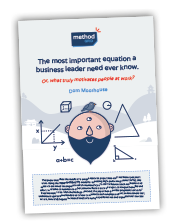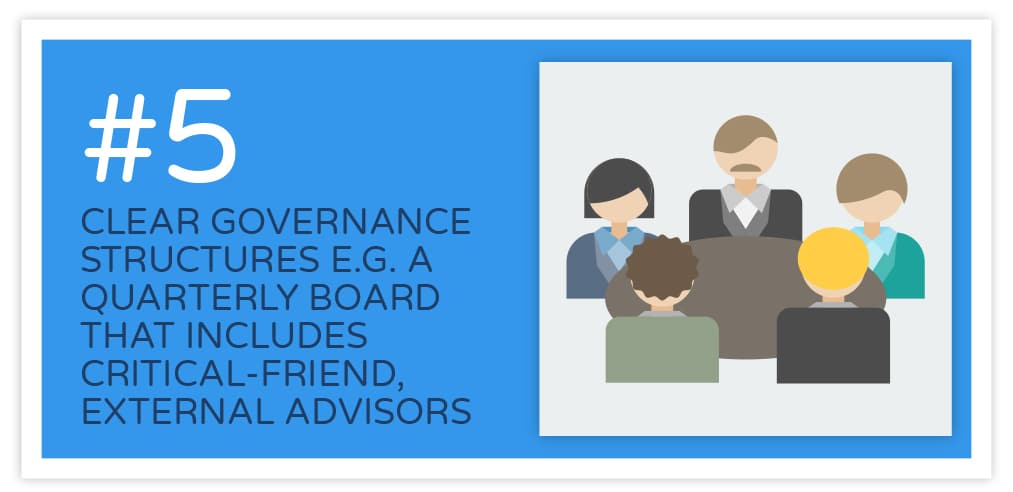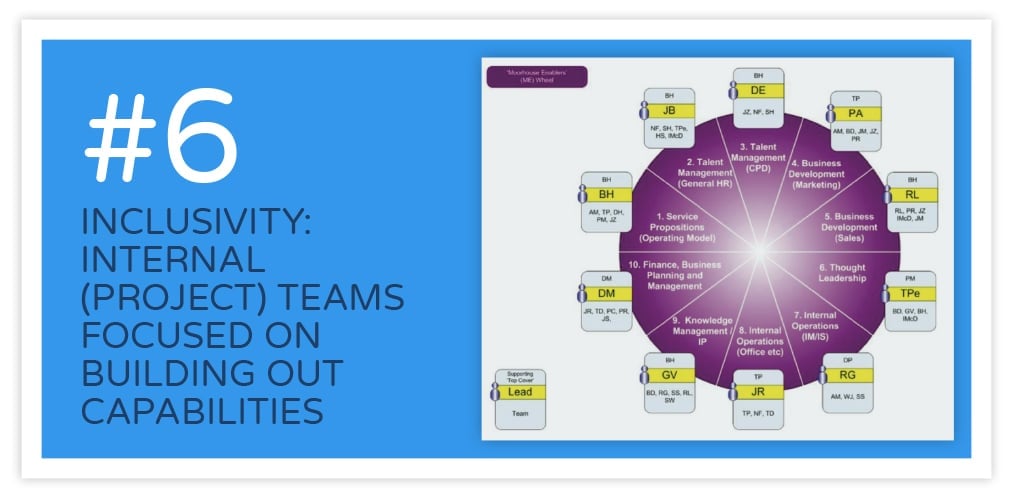Nurtured cultures - Walk the talk - Critical friends - Avoiding bear traps - Decision making tempo - Inclusivity - The everyday little step
In last week’s blog, I described how, for the last five years, I have run a three-day annual event for professional service firm leaders seeking to understand what makes a professional service firm successful? Attendees range from directors of $multi-million established companies seeking a growth inflection point through to the aspirational entrepreneur making final plans to leave employment and start-up a new business.
To kick-off this course, I briefly describe my personal entrepreneurial story – from singleton start-up to c. £20m sale in five years – in order that all subsequent references to it are given context. Rather than deliver this as a dull, chronological discourse I forced myself, when developing the materials, to reflect on this incredible journey and muster my personal top ten success factors – to take delegates quickly to the root of the entrepreneurial challenge.
Last week I shared the first three such success factors; this week, I am going to cover the next three.
So, here goes …
What makes a professional service firm successful?
Or, at least, what is my personal reflection on what contributed to the success of my own professional service business in these foundational years.
For success factors 1 to 3 – see last week’s blog.
4. A clear people-focused strategy (backed up by actual investment)

Last week, I talked about the importance of a nurtured culture of uncompromising (but ego less) client delivery. This point is subtly different. Aside, from the everyday focus on the behavioural vibe of your organization, what makes a professional service firm successful is the material investment in a people-focused strategy.
Such an investment needs to substantiate the easy rhetoric of “our people are the most important asset” throw-away line. If you believe this to be true – and you should! – then it needs to be backed up with respect to the actual time and money you invest in multiple people-based dimensions of your business: recruitment, professional development, retention and knowledge management.
Please send me
The most important equation a business leader need ever know
Or, what truly motivates people at work?

By example, at Moorhouse, we would take the entire firm away every quarter on a whole firm, multi-day, offsite Escape. Annually, this would involve transporting the whole team to a carefully sourced, inspirational setting. The image above is taken from one such trip when we took over a Kasbah in the foothills of Mount Toubkal in Morocco. There was, of course, a considerable cost of such moments in terms of both actual cost and the opportunity cost of unbilled revenue days. The payback, however, in terms of collectively-refreshed plans, professional development, knowledge share, celebration of team wins and rejuvenated spirits was immeasurable.
So, don’t just espouse the claim of being a people-centric business, believe it to your core and back it up with material investment. This is another critical factor in what makes a professional service firm successful.
5. Clear governance structures

Very early in the life of my new venture, at a point when it almost felt a little contrived – like we were playing at something above our station, I established a regular (quarterly) board process. On to this Board, I invited my impressive and highly-motivated senior colleagues and, super-importantly, one-to-two critical-friend, external advisors. Looking back, this construct was pivotal to our ordered, systematic growth and, with the experience of advising numerous other professional service firms, I have noted how often the existence of such a board process is correlate with methodical progress.
A well-organized board discipline ensures that strategy is regularly appraised and re-defined, your performance managed (to pre-set targets) and that you maintain compliance with relevant legal and regulatory strictures. Without such a discipline, professional service firms quickly fall into the trap of busy fools; months and years can rush by before any half-sensible pause-for-breath.
Well-chosen external advisors are so key. Clearly, you want to look for people with a successful track record in professional service firm growth, who carry your values, speak honestly and who you will enjoy working with. I chose my advisors very carefully and was blessed with excellent support in this regard. The real value of such externals (and I would ignore any business development component of this – the promise is often overdone) is two-fold. Firstly, they will steer you away from the occasional bear-trap – avoiding costly false starts along avenues that they know from experience are unlikely to be fruitful. This, however, is a fringe benefit; most business leaders intuitively know the right answer to the “what next?” growth decision. The real benefit of well-chosen board advisors is that they can speed up your decision-making tempo – asking the right questions, confirming your intuitions and, generally, keeping you honest to a desired pace of progress.
Governance clearly doesn’t stop at the board but get this foundation right and all ensuing structures and processes can flow, in an orderly fashion, from there.
6. Inclusivity:

Next up in this series of what makes a professional service firm successful – as based on my own reflection, I would state inclusivity.
What do I mean by this?
Inclusivity, in this context, talks to how successful professional service firms architect the development of their internal capabilities: how they go about building out those processes, functions and skills on which future growth is predicated. One can, occasionally, witness companies that ride an extraordinary period of somewhat-arbitrary growth – they luck out on a bountiful client relationship or on a really “hot” market-need moment. Without an accompanying focus on internal capability development, such firms invariably come crashing back down when the luck runs out. There is no sustaining firm architecture in place.
Conversely, what makes a professional service firm successful in the longer, more-predictable run is a consistent and very deliberate build out of requisite internal capabilities. The best, perhaps only, way of doing this is to involve the whole firm in this conversation: to be deliberately inclusive. By example, from a very early stage in my company’s life I mapped out ten critical areas on which I knew – following much research – future value could be built. By example, continuous development of our service propositions and tools, our talent management function, our marketing and sales disciplines, our financial controls and management information, our intellectual property assets etc. You get the drift.
Around each of these key areas, a project team was assigned with clear oversight and leadership assigned. The implore to the team was for everyone to get involved; to assign themselves to areas they were professionally curious and passionate about. Even more significantly, we expected everyone to care about the development of their own business; as such, every member of the firm sat in at least one such team.
This inclusive construct – with internal teams setting ambitious stretch goals each year and working in the margins of client work to deliver upon them – was another critical success factor in the Moorhouse story. Further, it also became a key differentiator for us in the recruitment challenge. Smart, motivated professionals want to be involved in the wider machinations of a business – to learn new skills and harness new experiences. Such an inclusive “call to arms”, therefore, often leads to higher levels of team engagement.
This is a feature I have observed in many successful, ever-ascendant companies. They have learned to balance the inherent time-management challenge of busy client delivery with a systematic, no-excuses, internal watch also. This involves adopting a “little step further, everyday” cf. “a big leap, tomorrow” attitude – and – harnessing everyone in this endeavour.
Method Grid has been built for such smart-thinking, forward-looking firms enabling as it does the continuous, incremental development of service methodologies, knowledge management networks and firm-wide intellectual property asset. You can sign up for a free trial here.
So, what’s next?
We will take a short break over Christmas but next up, in the New Year, I will continue this perspective on what makes a professional service firm successful and a reflection on my own personal journey from singleton start-up to valued business within five-years. Specifically, I am going to provide the next two critical success factors, in my top ten list, that enabled this fast growth to value.
Success factors 7-8 (Part 3): see blog
Success factors 9-10 (Part 4): see blog
Hopefully, you’ll join us on this journey. It’s totally free, and you don’t have to be a Method Grid customer (though you’re more than welcome to sign up for a free trial here).
We’ll be releasing a new post each week. To get each post emailed to you as soon as it’s published, sign up for the Climbing Mount Audacity mailing list below.
Climbing Mount Audacity…
From Startup to Scaleup!
We're sharing everything we know about how to build an awesome professional service firm (and enjoy the journey en route!) PLUS travel updates, reflections on our stumbles and general musings on our Method Grid journey.
Signup below to get the latest articles
direct to your inbox.

 Project and Program Management
Project and Program Management  Project Governance Framework
Project Governance Framework  Benefits Management Framework
Benefits Management Framework 






